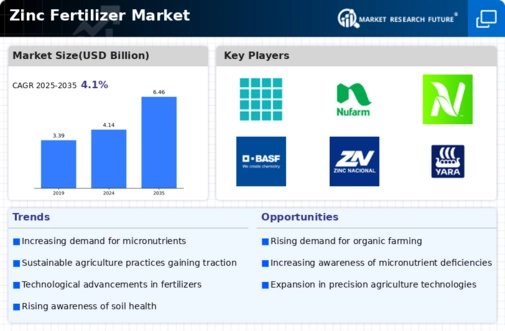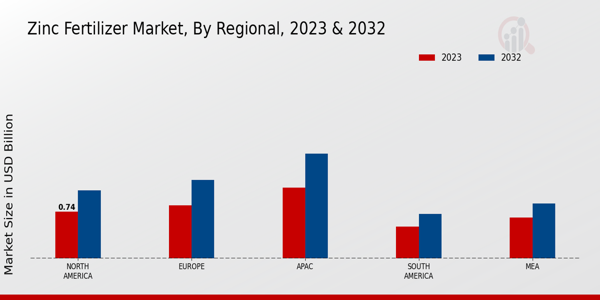Market Trends and Projections
The Global Zinc Fertilizer Market Industry is characterized by various trends and projections that indicate its growth potential. The market is anticipated to reach a valuation of 4.14 USD Billion in 2024, with a compound annual growth rate of 4.13% projected from 2025 to 2035. This growth is driven by factors such as rising awareness of micronutrient deficiencies, increasing agricultural productivity demands, and supportive government policies. The market's expansion reflects a broader shift towards sustainable agricultural practices, emphasizing the importance of zinc in enhancing crop yields and nutritional quality. These trends suggest a robust future for the zinc fertilizer sector.
Growing Awareness of Soil Health
There is a growing awareness of soil health among farmers and agricultural stakeholders, which positively impacts the Global Zinc Fertilizer Market Industry. As soil degradation and nutrient depletion become more recognized issues, the importance of micronutrients, including zinc, is increasingly acknowledged. Farmers are now more likely to invest in zinc fertilizers to restore soil fertility and enhance crop resilience. This shift in mindset is supported by research highlighting the correlation between soil health and agricultural productivity. Consequently, the market is poised for growth as more stakeholders prioritize sustainable practices that incorporate zinc fertilizers to improve soil quality and crop performance.
Government Initiatives and Support
Government initiatives play a crucial role in the Global Zinc Fertilizer Market Industry by promoting the use of micronutrients in agriculture. Various countries implement policies and programs aimed at enhancing soil fertility and crop productivity through the application of zinc fertilizers. For example, subsidies and educational campaigns are designed to encourage farmers to adopt these fertilizers, particularly in developing nations where zinc deficiency is widespread. Such initiatives not only support agricultural sustainability but also align with global efforts to combat malnutrition. As a result, the market is expected to grow steadily, contributing to an estimated value of 6.46 USD Billion by 2035.
Rising Demand for Zinc-Enriched Crops
The Global Zinc Fertilizer Market Industry experiences heightened demand due to the increasing need for zinc-enriched crops. As awareness of zinc's role in enhancing crop yield and nutritional quality grows, farmers are more inclined to utilize zinc fertilizers. This trend is particularly evident in regions where zinc deficiency in soil is prevalent, leading to lower agricultural productivity. For instance, in 2024, the market is projected to reach 4.14 USD Billion, reflecting the agricultural sector's shift towards sustainable practices that incorporate micronutrient fertilizers. This demand is likely to drive the market further as global food security becomes a pressing concern.
Increasing Global Population and Food Demand
The increasing global population and corresponding food demand serve as a significant driver for the Global Zinc Fertilizer Market Industry. As the world population continues to rise, projected to reach approximately 9.7 billion by 2050, the pressure on agricultural systems intensifies. This necessitates higher crop yields and improved nutritional quality, which zinc fertilizers can help achieve. Farmers are compelled to adopt practices that enhance productivity, leading to a greater reliance on micronutrient fertilizers. The market's growth trajectory reflects this urgency, with expectations of reaching 6.46 USD Billion by 2035, as agricultural stakeholders seek solutions to meet the escalating food requirements.
Technological Advancements in Fertilizer Production
Technological advancements in fertilizer production significantly influence the Global Zinc Fertilizer Market Industry. Innovations in manufacturing processes enhance the efficiency and effectiveness of zinc fertilizers, making them more appealing to farmers. For instance, the development of slow-release formulations allows for better nutrient management and reduced environmental impact. These advancements not only improve crop yields but also promote sustainable agricultural practices. The integration of precision agriculture technologies further optimizes the application of zinc fertilizers, ensuring that crops receive the necessary nutrients at the right time. This trend is expected to contribute to a compound annual growth rate of 4.13% from 2025 to 2035.









